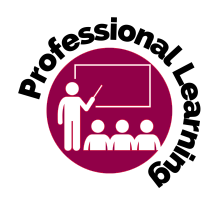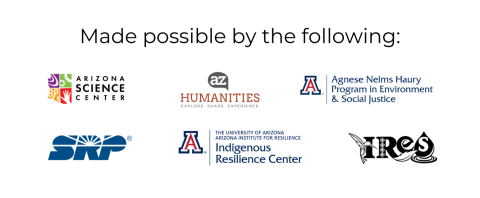Professional Learning & Resources
| Join the OIE PL Listserv | CLICK HERE | Resource: PL Padlet |
Per requirements in A.R.S. 15-244, Indian Education Act, the Office of Indian Education provides technical assistance to schools and tribal nations to meet the educational needs of Native American students, including the planning, development, implementation, and evaluation of curricula and instruction that are culturally relevant and aligned to state standards, and family and community involvement in the education of Native American students.
Professional Learning from the Office of Indian Education:
We compile our professional learning opportunities, such as webinars and recordings, online courses, and upcoming in-person events here. They are available to all educators in Arizona. Additionally, we have gathered free educational resources from tribal, local, state, and national organizations that can be used in classrooms and schools serving Native American students.
2025 Indigenous Literacy project
Stay tuned for details about the Fall 2025 Indigenous Literacy Project! We are working diligently to bring educators and unforgetable experience filled with learning and networking. Please check back soon for more information.
2025 Indigenous STEM Project
Thank you to those who attended and participated in our 2025 Indigenous STEM Symposium! Did you miss the virtual events? Visit the additional resources below to view recordings from the Indigenous STEM Educators Showcase and the STEM Professionals Panel!
Thank you to the following organizations!
Additional OIE resources
- Indigenous STEM Project 2025
- STEM Educators Showcase (virtual) - March 25, 2025
- Webinar Recording
- Password: B$lD195#
- Indigenous STEM Symposium at Arizona Science Center - April 27-28, 2025
- STEM Professionals Panel (virtual)- May 6, 2025
- Webinar Recording
- Password: 0vJ4kS+=
- Thank you to the following for making this event possible: Arizona Science Center, Arizona Humanities, SRP, Indigenous Resilience Center, and the Office of Societal Impact at the University of Arizona.
- STEM Educators Showcase (virtual) - March 25, 2025
- Integrating Indigenous Perspectives in K-12 Classrooms with Tribal Nations in Arizona
The Office of Indian Education regularly partners with Tribal Nations in Arizona to co-host free, in-person trainings open to any educators in the region. We invite school districts who are interested in this training to reach out to [email protected]
Previous Trainings
- Prescott Area with Yavapai-Prescott Indian Tribe | Fall 2023 | Slide Deck
- Verde Valley Area with Yavapai-Apache Nation | Spring 2024 | Slide Deck
- Summer Social Studies Seminar Series in collaboration with ADE K-12 Social Studies | Summer 2023
- Indigenous Perspectives (K-5)
- Tribal Sovereignty (K-12)
- Indigenous Perspectives (6-12)
- Tribal Sovereignty (K-12)
- NOTE: If you're interested in viewing recordings and resources for this series, use the links below from Summer 2022
- K-12 Educator Night: Teaching Academic Standards with Indigenous Storytelling | Spring 2023
- Teaching Tribal Sovereignty in K-12 Classrooms | Spring 2023
- Padlet from Session (resources, slide deck, etc.)
- Reclaiming the Narrative: Teaching about Native American Boarding Schools | Summer 2022
- Part 1: History and Impacts of Native American Boarding Schools
- Webinar Recording | Slide Deck
- Video Presentation from Professor Pino – History of Federal Policies and Native American Boarding Schools | Viewing Guide with timestamps
- Part 2: Trauma-Informed and Culturally Responsive Teaching Guidance and Resources
- Grades K – 2 Webinar Recording | Slide Deck
- Grades 3 – 5 Webinar Recording | Slide Deck
- Grades 6 – 8 Webinar Recording | Slide Deck
- Grades 9 – 12 Webinar Recording | Slide Deck
- Collection of Resources for All Grade Levels (webpages, lessons, videos, articles, etc.)
- Part 1: History and Impacts of Native American Boarding Schools
- Respectfully Integrating Indigenous Perspectives in Social Studies Instruction | Summer 2022
- Spotlight on K-2 Classrooms Webinar Recording | Slide Deck
- Spotlight on 3-5 Classrooms Webinar Recording | Slide Deck
- Spotlight on 6-8 Classrooms Webinar Recording | Slide Deck
- Spotlight on 9-12 Classrooms Webinar Recording | Slide Deck
- Collection of Resources for All Grade Levels (webpages, lessons, videos, articles, etc.)
- Changing the Narrative: K-12 Indigenous Literacy and Literature Symposium | Annual Fall Event
Changing the Narrative: K-12 Indigenous Language & Literacy Symposium 2022 from Arizona Humanities on Vimeo.
- Indigenous Texts Project Report | Read Report Here
- 2022 Slide Decks
- Applying Culturally Sustaining-Revitalizing Practices in ELA Instruction
Presented by: Office of Indian Education and Office of Academic Standards, English Language Arts - Literary Representation and Analysis – Interactive Book Display & Discussion
Presented by: ASU Labriola National American Indian Data Center - Valuing Indigenous Knowledge Systems and Respecting Cultural Protocols
Presented by: ASU Labriola National American Indian Data Center - Leveraging Oral Traditions to Support Academic Language and Literacy
Presented by: Office of English Language Acquisition Services and Office of Indian Education - Planning for Teaching with Indigenous Texts – Collaboration and Planning
Presented by: Office of Academic Standards – English Language Arts and Office of Indian Education - Interactive Library Guide created by the ASU Labriola National American Indian Data Center: Click Here
- Collection of Resources from the Arizona Department of Education: Click Here
- Applying Culturally Sustaining-Revitalizing Practices in ELA Instruction
Part 1 | November 2023
This session will provide participants with the opportunity to identify multiple sources of data that can be used, distinguish multiple types of data that can be collected, and use data to evaluate grant program progress and provide evidence of impact.
- Session Slide Deck
- Zoom Recording
- Password: OIE_DATA23/24
Part 2 | February 2024
This session will provide participants with the opportunity to organize and clean multiple data sources, use multiple approaches to analyze data, and support data-driven decision-making for grant projects, programs, and initiatives.
- Session Slide Deck
- Zoom Recording
- Password: OIE_DATA23/24
Part 3 | April 2024
This session will provide participants with the opportunity to understand and visualize data, select appropriate visualizations, and learn design principles for effective visualization.
- Session Slide Deck
- Zoom Recording
- Password: OIE_DATA23/24
Professional Learning Opportunities from External Organizations
- Preparing Indigenous Teachers for Arizona Schools (PITAS)
- Dine Institute for Navajo Nation (DINE)
- Indigenous Early Childhood Educators Professional Development Fellowship (IECE)
- Culturally Responsive Schooling with/in Indigenous Communities Professional Development Institute (CRS)
- Indian Country School Counselors Institute (ICSCI)
- Teacher Leadership Shiłgozhóó Institute (TLSI)
- FREE Webinar Recordings on Indian Education Topics
- Educator Professional Development: Recognizing Boarding School Era Historical Trauma










